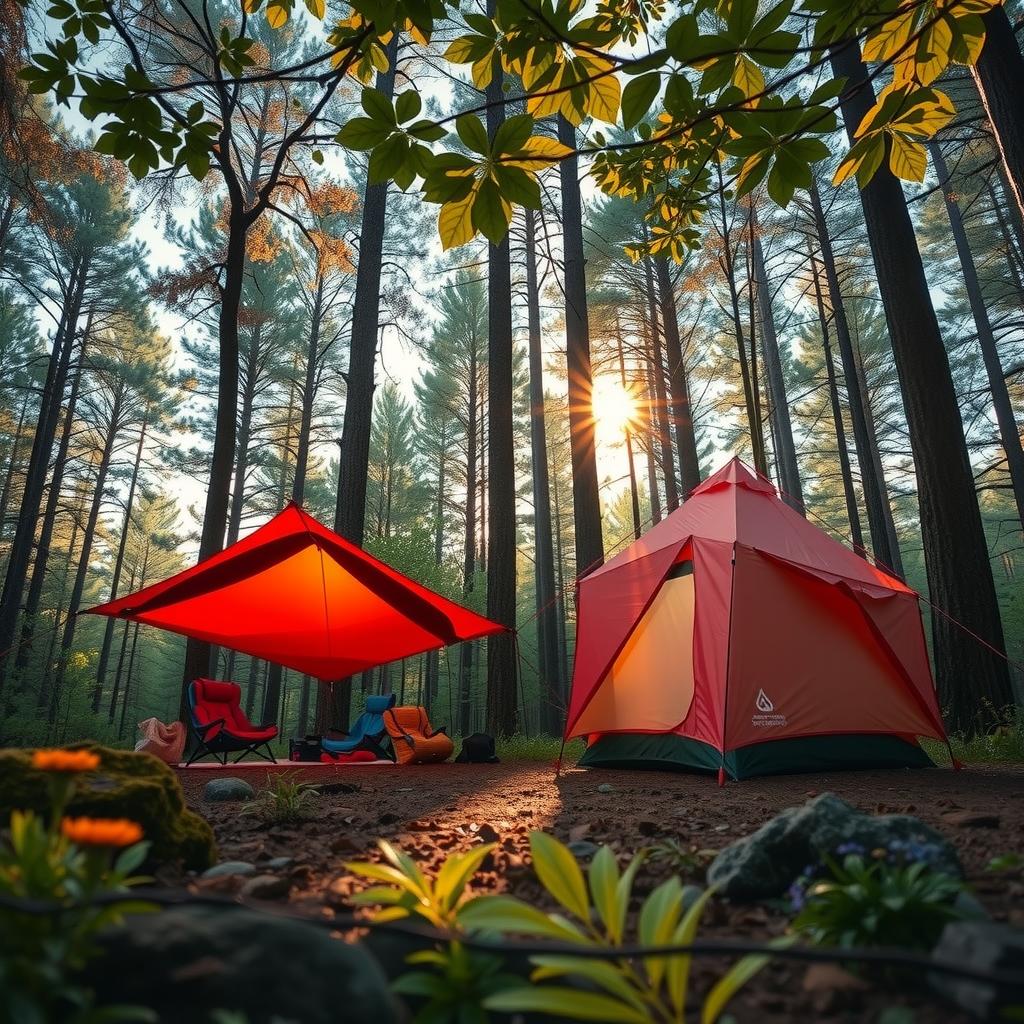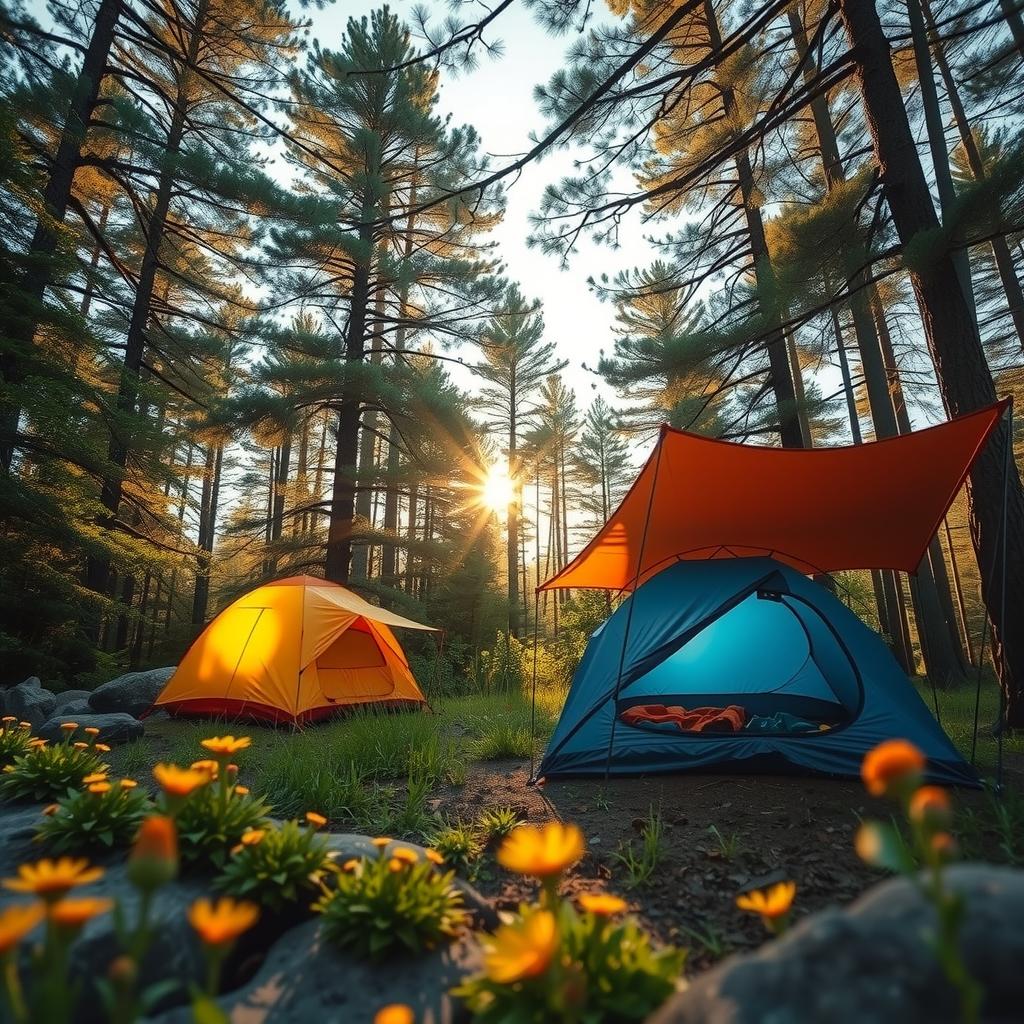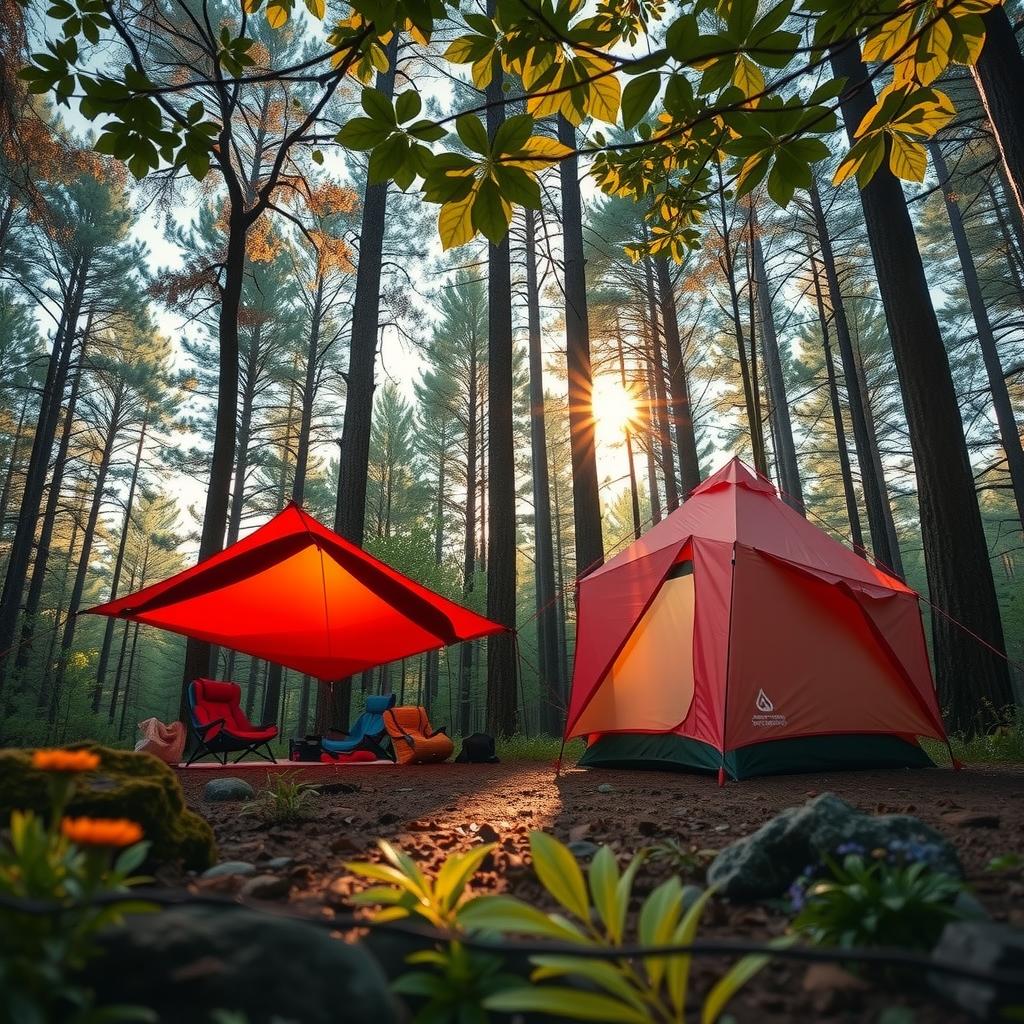When it comes to outdoor adventures, having the right gear can make all the difference. Among essential items for campers and hikers alike, a 3×3 Camping Tarp or a 4×4 Camping Tarp stands out as a versatile solution for creating an effective shelter. But with various setup configurations available, how does one choose between these two sizes? This article delves into the nuances of tarp setups, exploring different configuration options that can enhance your outdoor experience while ensuring you are well-protected from the elements.
Understanding the distinct advantages of each tarp size is crucial for any camping enthusiast. The 3×3 Camping Tarp, known for its lightweight and compact design, offers incredible flexibility in tight spaces—ideal when navigating dense woodlands or if you’re traveling solo. On the other hand, the robust 4×4 Camping Tarp provides ample coverage and stability; it’s perfect for larger groups or when additional equipment needs protection from rain or sun exposure. By examining various tarping techniques associated with both sizes, readers will gain insights into how to maximize their outdoor shelter capabilities.
This guide aims not only to clarify which camping tarp might suit specific needs but also to introduce effective tarp setup methods that cater to varying environments and weather conditions. Whether it’s setting up during unexpected rainfall or creating shade on sunny afternoons, understanding these configurations empowers campers with practical camping tips. With this knowledge at their fingertips, enthusiasts will feel more confident venturing into nature.
As we explore these options further in this comprehensive setup guide, readers will discover not just what makes each tarp unique but also how they can elevate their overall camping experience through strategic planning and execution of tarping techniques. So let’s dive deeper into whether a 3×3 Camping Tarp or a 4×4 Camping Tarp aligns better with your next adventure!

Key Points:
-
Size Matters: Understanding the 3×3 vs. 4×4 Options
When selecting a camping tarp, size plays a crucial role in determining the level of coverage and protection it provides. The 3×3 Camping Tarp is ideal for solo campers or those who prefer minimalism, offering enough space to shield essential gear while being easily portable. Conversely, the 4×4 Camping Tarp caters to larger groups or families by providing expansive coverage suitable for communal activities such as cooking and relaxing outdoors. -
Versatility in Setup Techniques
Exploring various tarp setup methods is essential for maximizing the effectiveness of either tarp size. Campers can utilize different tarping techniques based on their needs; whether deploying the compact 3×3 Camping Tarp quickly during sudden rain showers or using the spacious 4×4 Camping Tarp to create an inviting area under starry skies, understanding these options enhances overall adaptability in outdoor shelters. -
Ease of Use During Outdoor Adventures
The ease with which each camping tarp can be set up significantly affects a camper’s experience. The lightweight nature of the 3×3 Camping Tarp allows for quick deployments even in challenging weather conditions, while the generous dimensions of the 4×4 Camping Tarp, although requiring more effort initially, provide ample space that promotes comfort and social interaction among campers. Knowing how to efficiently utilize these configurations will ultimately enrich any adventure into nature with family and friends.

Comparing Dimensions: Understanding the 3×3 and 4×4 Camping Tarps
Key Features of Each Tarp Size
When it comes to selecting a camping tarp, understanding the dimensions is crucial for determining its suitability for various outdoor activities. The 3×3 Camping Tarp offers a compact solution ideal for minimalist campers or solo adventurers. Its smaller size makes it lightweight and easy to pack, which can be especially beneficial during long treks where every ounce counts. On the other hand, the 4×4 Camping Tarp provides additional coverage that can accommodate multiple people or larger gear setups. This tarp is particularly advantageous in family camping scenarios or when weather conditions warrant extra protection from rain and wind. With both tarps available in durable materials designed to withstand harsh elements, choosing between them often boils down to individual needs regarding weight versus space.
Versatility in Use: Outdoor Applications of Each Tarp
How Different Sizes Meet Varied Needs
The versatility of a camping tarp lies not just in its size but also in how effectively one can utilize it based on specific outdoor situations. A 3×3 Camping Tarp excels as an emergency shelter or cooking area due to its quick setup capabilities; seasoned campers appreciate how easily they can deploy this tarp using straightforward tarping techniques like A-frame configurations or lean-tos. Conversely, the 4×4 Camping Tarp, with its increased surface area, caters well to group activities such as communal dining spaces during meals or even serves as a sizable ground cover for equipment storage under adverse weather conditions. Both tarps support diverse setup methods that adapt well across different terrains ranging from dense forests to open fields while ensuring adequate shielding against rain and sun.
Weight Considerations: Portability vs Capacity
Balancing Travel Convenience with Shelter Needs
Weight considerations play a significant role when deciding between the 3×3 Camping Tarp and the 4×4 Camping Tarp—especially for backpackers who prioritize portability above all else. The lighter profile of the 3-meter square option ensures ease of transport without sacrificing essential functionality necessary during hikes into remote areas where comfort cannot be taken for granted. However, those venturing out with families might find that carrying slightly heavier gear becomes worthwhile should they opt for more spacious shelters provided by larger tarps like their 4-meter counterpart; these offer an expanded living area conducive not only for sleeping but also relaxing around campfires without feeling cramped under limited space constraints common among smaller configurations.
Environmental Factors: Climate Adaptation Strategies
Choosing Your Shelter Based on Weather Conditions
Weather plays an undeniable role in determining which camping tarp will serve best at any given time—a consideration heightened when evaluating options ranging from basic models like the 3×3 Camping Tarp up through comprehensive solutions exemplified by offerings such as the robust yet versatile 4×4 Camping Tarp designed specifically with adaptability against unpredictable climates front-of-mind! For instance, if heavy rain is forecasted during your trip duration ahead of embarking into nature’s embrace (which requires effective waterproofing measures), then opting toward utilizing more extensive shelters may prove wiser than relying solely upon minimalistic alternatives amidst severe storms bearing down overhead! Similarly so too must campers consider possible wind directions impacting shelter placement along chosen campsites—larger structures provide greater resilience against gusts while simultaneously allowing simultaneous ventilation within enclosed spaces keeping occupants comfortable throughout their stay outdoors regardless seasonality present therein!
Conclusion: Making Your Choice Count
Final Thoughts on Selecting Between Sizes
Ultimately selecting between either type boils down largely upon personal preferences coupled alongside intended uses whether leisurely outings near established grounds versus rugged adventures traversing less-charted territories—all encompassed within broader frameworks concerning cost-effectiveness balanced alongside performance metrics evaluated per situation encountered outdoors! Emphasizing key aspects surrounding each product offering enables better-informed decisions ensuring maximum enjoyment derived from experiences gained while embracing nature’s splendor together wherever paths lead forth next—with appropriate tools always ready at hand supporting every endeavor undertaken joyfully beneath starlit skies overhead!
Effective Setup Techniques for Tarps
Navigating Group Dynamics and Environmental Conditions
When it comes to outdoor adventures, having the right 3×3 Camping Tarp or 4×4 Camping Tarp can significantly enhance the experience. Understanding effective setup techniques tailored to various group dynamics and environmental conditions is essential. For smaller groups or solo campers, the compact 3×3 Camping Tarp provides sufficient coverage while remaining lightweight and easy to manage. This tarp can be configured in a variety of ways—whether as a simple A-frame shelter for rain protection or as an overhead canopy for shade during sunny afternoons. Proper tensioning of guy lines is crucial; using adjustable knots will allow users to tighten or loosen their setups based on changing weather patterns. Moreover, selecting appropriate anchor points such as trees or stakes ensures stability, particularly in windy conditions.
Conversely, larger groups may find that the versatile 4×4 Camping Tarp caters better to their needs by providing ample space beneath its expansive surface area. When setting up this larger tarp, one must consider not only the number of people but also potential gear storage requirements underneath its cover. Configuring it as a high-pitched ridge line allows air circulation while offering significant protection from rainfall without pooling issues that lower configurations might present. Additionally, utilizing multiple tie-out points enables greater adaptability for different terrains and environmental challenges encountered during camping trips. Incorporating these thoughtful setup methods leads to an enhanced outdoor shelter experience.
Choosing Between Sizes: The Practical Decision
Factors Influencing Your Selection Process
Selecting between a 3×3 Camping Tarp and a 4×4 Camping Tarp involves careful consideration of several factors including group size, intended use cases, and specific environmental challenges anticipated during outings. For instance, if one plans excursions with minimal gear—perhaps just personal items—the smaller tarp suffices perfectly without adding unnecessary weight to one’s pack load; however, when embarking on extended trips with more participants requiring shared space for cooking or socializing under cover from elements like sun or rain—a larger option becomes indispensable.
In terms of configuration options available with each size tarping technique differs significantly too; smaller tarps often lend themselves well towards straightforward setups such as flat-lay designs suited primarily for individual use whereas bigger variants allow complex arrangements capable of hosting multiple activities simultaneously—even accommodating large picnic gatherings comfortably shielded from inclement weather! Furthermore attentive planners should also assess local climates before making final decisions regarding which dimensions are best suited since frequent storms necessitate sturdy structures able withstand harsher winds regardless if opting small-medium-large formats alike.
Mastering Outdoor Shelter Construction
Advanced Techniques Using Tarpaulins
Mastering advanced tarping techniques plays an integral role in maximizing coverage when constructing outdoor shelters using either the 3×3 Camping Tarp or the 4×4 Camping Tarp. One innovative method involves creating ‘walls’ by extending side panels downwards—not only does this provide additional windbreaks but enhances overall warmth within enclosed spaces which proves vital especially during colder months outdoors! Adding extra guylines positioned at strategic angles further reinforces stability against strong gusts ensuring your haven remains intact throughout varying climatic scenarios faced whilst adventuring into nature’s embrace.
Moreover incorporating reflective materials underneath these configurations aids thermal regulation keeping occupants cozy regardless whether basking under sunlight midday enjoying leisure time reading novels sipping hot beverages—or ward off chilly breezes evenings spent around campfires recounting tales amongst friends sharing laughter memories forged through experiences they’ll cherish long after leaving campsite behind them… Thus both efficient setups coupled clever adaptations lead ultimately successful expeditions enhancing joy derived simply being surrounded raw beauty awaiting discovery beyond horizons beckoning exploration – all thanks cleverly designed products like “Camping Tarps”.
Creative Uses of Tarps for Camping Comfort
Discover the Versatility of Tarps in Outdoor Adventures
When venturing into the wild, one often seeks comfort and protection against unpredictable weather. A 3×3 Camping Tarp or 4×4 Camping Tarp can be integral to enhancing any camping experience. These versatile pieces of gear not only serve as shelters but also offer various creative uses that can significantly improve outdoor adventures. For instance, setting up a tarp as an overhead shelter provides shade during hot afternoons while keeping campers dry during unexpected rain showers. By utilizing simple tarping techniques such as A-frame setups or lean-tos, users can create effective barriers against wind and water, ensuring a more enjoyable time spent outdoors.
To maximize the utility of a 3×3 Camping Tarp, adventurers can explore diverse configuration options tailored to their specific needs. For example, when gathering around a campfire in cooler conditions, positioning the tarp at an angle over seating areas creates warmth retention without compromising ventilation—an ideal setup guide for cozy evenings under the stars. Moreover, this configuration aids in safeguarding equipment from dew and moisture overnight while allowing easy access to essential items stored beneath it.
Another innovative approach involves transforming tarps into makeshift privacy screens or changing rooms at campsites where space is limited or communal facilities are unavailable. By securing one side of a 4×4 Camping Tarp between two trees with guy lines and stakes, users achieve both privacy and convenience when needing to change clothes or freshen up after long hikes—a practical camping tip that enhances comfort levels significantly. Additionally, combining multiple tarps expands outdoor living spaces; linking several together allows families or groups to enjoy meals outside regardless of weather conditions.
In addition to these applications, incorporating strategic use of colors plays an important role as well—bright colored tarps stand out against natural backdrops making them easily identifiable from afar should someone wander off on trails nearby; thus providing peace-of-mind safety measures for everyone involved during outdoor excursions! Furthermore having reflective materials integrated within certain models improves visibility at night contributing further towards ensuring secure campsite environments overall.
Finally yet importantly—the proper care taken with tarping methods reflects on their longevity too! Regularly inspecting seams along edges helps prevent wear-and-tear incidents occurring prematurely extending life expectancy dramatically; coupled alongside appropriate storage procedures post-trip ensures these valuable assets remain ready-to-go whenever adventure calls next time round!
Utilizing products like the 3×3 Camping Tarp effectively transforms ordinary camping experiences into extraordinary ones by leveraging creativity through thoughtful implementations across various aspects—from sheltering solutions all through aesthetic enhancements promoting safety/visibility considerations too—all aimed toward maximizing joy found amid nature’s breathtaking beauty!
Efficient Setup Techniques for Maximum Enjoyment
Mastering Your Shelter Configuration
For those looking to optimize their outdoor experiences further while camping with ease using tools like the 3×3 Camping Tarp, mastering different tarp setup methods becomes vital knowledge every enthusiast should possess! Whether planning weekend getaways involving friends/family gatherings—or embarking solo expeditions deep within nature’s embrace—understanding how best utilize available resources drastically influences overall enjoyment levels attained throughout each journey undertaken together!
Starting off basic configurations enables novices quickly grasp foundational principles governing successful installations before progressing onto more complex arrangements later down line—for example learning straightforward square riggings first lays groundwork understanding angles/degrees critical constructing anything else thereafter successfully! The adaptability inherent within designs like these facilitates swift transitions adapting varying environmental challenges encountered thereby ultimately enhancing resilience experienced out there amidst wilderness!
One popular method amongst seasoned campers revolves around creating tensioned ridge lines which allow adjustable height settings according individual preferences based upon terrain characteristics surrounding chosen site location—that said fixtures enable ample airflow circulation whilst maintaining structural integrity despite strong gusts potentially threatening stability otherwise achieved otherwise if neglected altogether inadvertently leading disastrous outcomes instead—thus demonstrating importance placing emphasis functionality prioritized above aesthetics alone perhaps initially perceived naturally speaking here too therefore worth noting especially considering risk factors associated generally involved activities enjoyed frequently outdoors alike sometimes overlooked casually surprisingly so accordingly henceforth deem crucial share widely amongst peer networks collectively gained insights shared readily informally via word mouth generally speaking clearly evident across varied communities engaged similarly behavior patterns observed regularly day-in/day-out nationally indeed globally acknowledged circumstances faced jointly inevitably reinforcing bonds forged stronger friendships cultivated memories cherished forever nonetheless beyond mere appearances alone truly reflecting essence connecting people closely united commonly shared interests pursuing exploration ventures passionately pursued continually thriving continuously evolving organically over time unmistakably identified unmistakably today worldwide recognized universally celebrated spirited camaraderie fostered growth seen everywhere surely bridging divides fostering unity witnessed among diverse individuals drawn closer still nearer paramount aspirations cherished dearly forthwith indefatigably striving reach fulfilment thereof notwithstanding challenges faced unflinchingly embraced boldly undeterred onward pushing always forward unwavering resolutely everlastingly respected deeply rooted traditions passed down generations standing proud resilient adaptable ever-changing face adversity confronting obstacles aplenty surmountable triumphantly overcoming hurdles incessantly perpetually rallying spirits high keep going gathered strength renewed invigorated hopeful hearts bravely forging ahead enduring thriving harmoniously regardless storms raging temp
Frequently Asked Questions:
Q: What are the main advantages of using a 3×3 Camping Tarp compared to a 4×4 Camping Tarp?
A: The primary advantage of the 3×3 Camping Tarp lies in its compact size, making it ideal for solo campers or those who prioritize mobility. It can be quickly deployed and offers sufficient protection for essential gear. In contrast, the 4×4 Camping Tarp provides ample space, perfect for families or groups looking to create communal areas for activities such as cooking or socializing.
Q: Are there specific tarp setup methods recommended for each tarp size?
A: Absolutely! For the 3×3 Camping Tarp, simple configurations like an A-frame or lean-to setup work well due to their quick deployment capabilities. Meanwhile, the larger 4×4 Camping Tarp allows for more complex arrangements such as a diamond configuration that maximizes coverage while providing flexibility against wind and rain.
Q: How do weather conditions influence the choice between these two tarp sizes?
A: Weather conditions play a critical role in this decision. If heading into unpredictable weather with potential high winds or rain, many campers might opt for the sturdier coverage offered by a 4×4 Camping Tarp, which can better accommodate group needs under adverse conditions. On calmer days, however, a compact and lightweight option like the 3×3 Camping Tarp is often sufficient and easier to manage during travel.

